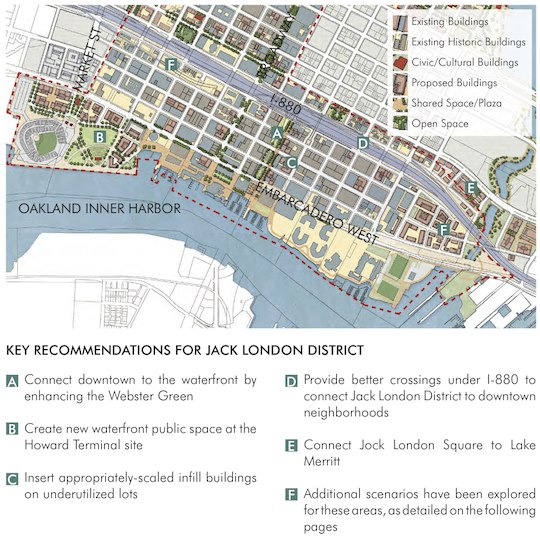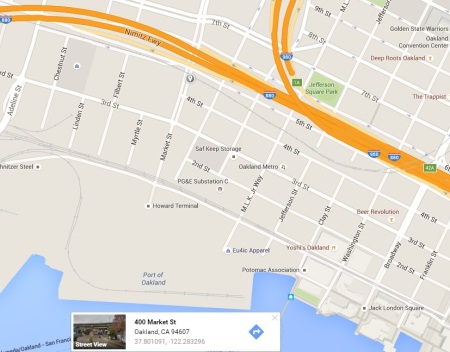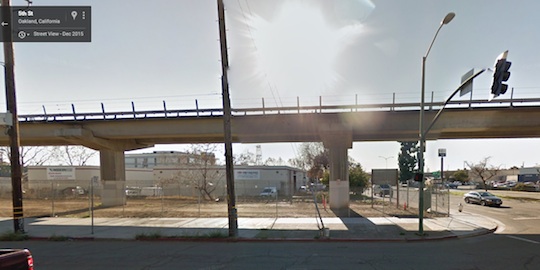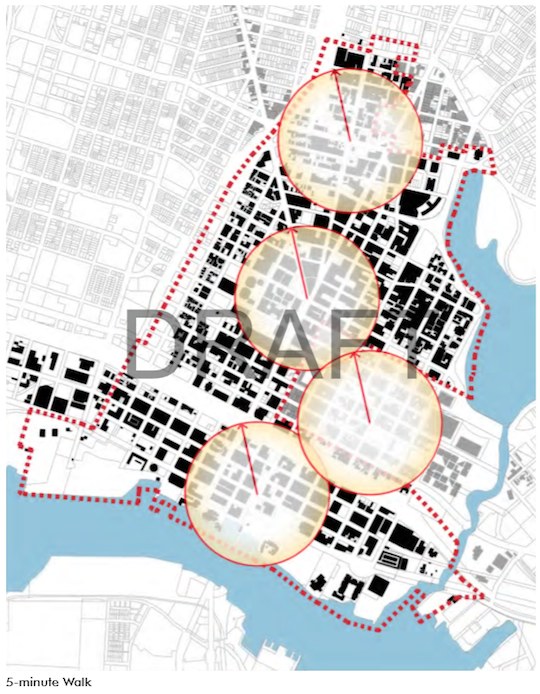2/7/17 – I originally posted this a year ago yesterday. The basic information hasn’t changed, so I’m reposting it now. This comes as the Chronicle’s Scott Ostler reported on the A’s potentially requesting light rail (a streetcar) to bridge the gap between BART and Howard Terminal. Have at it. – ML
My last article with Howard Terminal as the main subject (and not as an aside) was posted on November 15, 2014. That was nearly 15 months ago. Since then, few things have changed in the immediate area. The site remains without a tenant, short or long-term. While relationships with shipping companies SSA Marine and Matson solidified, the same can’t be said for rival Ports America, which pulled out of Oakland completely.
No site studies were completed on Howard Terminal, so in the event the site become an official relocation site for the A’s in the future, it will again come time to figure out just how much it costs and how long it will take to get the site ready. Thankfully, in Mayor Schaaf’s recent push for HT, a preliminary figure has been floated for site prep and infrastructure: $90 million. To me that sounds conveniently low, especially because $90 million is also the figure to get the Coliseum ready for the Raiders – even though we don’t know how much can or would be developed there.
Fortunately, we know that the infrastructure budget would include at least one bridge extending Market Street over the Embarcadero and Union Pacific tracks to Howard Terminal. There’s also a good chance we’d see a small parking garage to serve the stadium, probably for players, management, and VIPs such as suite holders. The actual cleanup cost is still to be determined, since we don’t have a proper sense of the footprint and placement of the ballpark in relation to the waterfront, not to mention the fate of the rest of the 50 acres.
Oakland has embarked on updating its Downtown Specific Plan. As is often the case when such updates come around, the city has chosen to expand its definition of downtown, now including Howard Terminal as part of an expanded Jack London district. This is a good move if the purpose is to recast HT as Jack London Square’s commercial flank to the west, instead of HT’s legacy as a dirty, blue collar, West Oakland port facility.

Howard Terminal and Ballpark at the far left of expanded Jack London District
The expansion makes the Jack London District quite large, extending 1.25 miles from west to east. That’s as long as a stroll from the marina all the way to 21st Street down Broadway. Or in walking distance, 25 minutes or so. To get a sense of distance and walkability, Oakland plotted out a series of maps showing rights-of-way, transit access, and walking distance from key points. Take this map, for instance:
Based on where the the ballpark is located, it’s about 10 minutes from Jack London Square. It’s another 10 minutes to the nearest entrance for the 12th Street BART station. That’s going to require some sort transit option to bridge that distance, either via a more frequent Broadway Shuttle, the long-rumored Streetcar project, or another BART station in the vicinity of JLS. Because BART inclines from a tunnel to an elevated viaduct as it runs by 880, the most likely place for a station would be Market and 5th St. That’s a great location relative to Howard Terminal, only 1/4-mile away. There’s room and BART-owned land there for a new station. To accommodate BART’s up to 710-foot trains, the station would have to be located between Market and Brush Streets.

Gray marker on Market St denotes location of BART infill station

BART aerial at 5th Street and Market Street
The downside of BART at Market and 5th is that it’s 3/4-mile from Jack London Square, though at least it would be in the district (barely). A streetcar would conceivably serve more locals and non-ballpark users, but its route would run closest at JLS, again, 1/2-mile away. In a 2012 study, the streetcar’s estimated cost was $202 million. An infill aerial BART station would cost $70 million or more to construct. To me, if there’s a choice it’s a no brainer – build the BART station. But I’m not an Oakland resident, I’m an A’s fan who cares most about BART access. Citizens of Downtown Oakland who want a more comprehensive transit plan for their neighborhood may not find such an option satisfactory. The location is also not conducive to a big transit-oriented development plan, which makes it less attractive for grant funding, a possible necessity for construction.
Some may think that this infrastructure is unnecessary for the ballpark. They point to the numerous fans who walk from the Embarcardero BART station the long way along the waterfront to AT&T Park. Yes, people do that. They do it because it’s scenic. The walk from 12th Street to Howard Terminal is not scenic, whether you’re taking Broadway, Washington, or MLK. Forcing people to walk 20 minutes after taking in many cases a 15-25 minute BART ride is not convenient. It’s not up to the standards the public expects for transit availability. And it’s incredibly disrespectful to the needs of the disabled and seniors. You know what those people have in San Francisco? They have the ability to transfer to MUNI without leaving the station. Thousands of able-bodied fans do the same thing. They have the option to either walk or take transit directly to the park. That’s pretty close to ideal. Or if you want ideal access, there’s the Coliseum and the BART bridge. A’s staff are on hand at each end to help fans in wheelchairs. In upgrading ballparks, we shouldn’t downgrade access. We’re better than that.

980 park!
If the “tear down 980” sect has any say, anything like 980 park is a nonstarter.
How long would it take to get a new BART station financed, approved, designed and built? 15-20 years?
BART to San Jose has been a pipe dream for decades
Wouldn’t the BART extension from the Coliseum to OAK be a better parallel than the BART extensions to San Jose in terms of time and cost?
BART San Jose is going to be reality in by 2018
Shouldn’t take more than half that time. It’s not a BART extension. The only thing that has to be built is the station and supporting equipment. BART’s concern is making sure the headways through the Transbay Tube stay constant, so as long as that is covered I can’t see why it would take decades.
West Pleasanton infill station took about 5 years with a 2 year delay
ballpark guess, how much would it realistically cost to build a park at howard terminal. i’m talking everything from park construction, transportation improvements, and cleanup/prepping the site?
800-900 million at the very least?
The reality is nothing will happen for two more years ( at best). There is the little issue of the Raiders. ( do they stay in Oakland or move?). I also suspect that the Mayor will wait until after she is re-elected. My gut feeling is the Chargers wil move to LA, and the RaIders to San Diego. But what if Las Vegas becomes available? Maybe the Raiders stay in Oakland until then? Lots of variables at work.
I pretty much feel the same way. However, the Raiders (Mark Davis) need to make up their minds, are you staying in Oakland or not? If not, move your ass to Levis temporarily and let Oakland, the A’s, and everyone else move on. Libby needs to push on this!
According to transportation access studies, a ballpark/stadium would be considered accessible to mass transit if said facility is located within 1/4 mile to/from the nearest train station. ML’s suggested location for a new BART station would be just within that distance limit. The problem, as ML points out, is that not enough economic development is anticipated to be spurred on in the surrounding new BART station area to warrant the spending of funds to build that new station. Ultimately, if a new A’s ballpark within Oakland is ever to be built, it will have to be located near a current BART station within the BART system. The current Coliseum site, Laney College, and Victory Court would all be ideal new ballpark locations within Oakland, in terms of access to BART.
*yawn*
Why is this still being talked about? MLB and the A’s have rejected this site multiple times already.
Is there any chance that an intermodal transportation center could be built at HT (Market and 5th). Would there be enough room for Amtrak, Intercity bus (Greyhound and Megabus), and a Bart station? HT is already in close proximity to the Oakland ferry landing.
Not likely. The Jack London Amtrak station is barely 20 years old. That investment is meant to last for decades. Most of the land in the Market/5th area is privately owned, so it would be incredibly expensive to build a new transit hub there. The Coliseum area already has plans for a transit hub which will be much easier to pull off, though it isn’t downtown.
Why futz around? Put in a gameday “Wye” on the existing system between Oakland 12th and Oakland West, similar to what’s on the BART between San Bruno and Millbrae that services SFO. Put an additional $2 (or so) cost on the ticket to help pay for it. Let the blue line bypass the JLS station for those who wish to avoid gameday traffic – those Dublin-Pleasanton folk can transfer at Bayfair. Run the aerial structure right down the middle of Market Street and over the SP tracks.
Go big or go home.
… or stay where you already have the transportation options you’d have to pay through the nose to replace.
BART traffic with weekday games would coincide with rush hour.
You can’t re-route and delay the rush hour commute to support a baseball stadium.
Oakland will eventually need a multi-modal transportation center due to the construction of the CA HSR system. Amtrak/HSR, BART, Greyhound, and local bus lines would all likely use such a station. 5th/Market could be the place it gets built.
Or… The Coliseum, where all of that exists plus an Airport connector.
I agree that a new BART station would be most preferable. But you also say that BART to MUNI transfer in SF is pretty close to ideal. If that is the case, wouldn’t a BART to AC Transit transfer (pretty cheap) also be pretty close to ideal?
Because of the large volumes of people leaving (and to a lesser extent arriving) at the same time, it’s difficult to physically get everyone on the bus in a timely fashion. Plus for buses you pay when you get on, as opposed to Muni and BART where you pay before you get to the train. Light rail and BART can load and unload much faster.
Buses are far from ideal.
There is no law that says that you can’t pay for a bus in advance and must pay for a bus when you get on. Your ticket could include the return as well, so there would be no paying at the time of leaving. Also, buses could be lined up after the game to handle volumes of people.
That being said, I like the BART station better.
They do this bus thing in Downtown Atlanta to get to Turner Field. I believe it was about a 1.5 mile trip and it took over 30 minutes for me from the time I got in line to the time I was at Turner Field and I was on the 3rd bus to leave. It was terrible.
It has nothing to do with paying and everything to do with limited capacity. They did exactly what you said, buses lined up outside of a MARTA station, I think I paid something when I got on and it was relatively quick, but I don’t really remember how much (I want to say $2).
You have hundreds (probably more than a thousand) of people standing in a huge line and a small portion get on a bus and leave. It was like the Coliseum BART platform after a fireworks game only less people and it took much longer to dissipate (I admit this is an assumption, I looked at the line as we left and it stretched on for a looooong way).
Buses are great as a compliment to real mass transit, light rail, etc. They are ineffective as the primary method of transportation when you are trying to move thousands of people a mile.
That said, for me… if it’s a mile away, my wife, kids and I are hoofin’ it and it isn’t a big deal.
Why are we talking about H terminal again? Not gonna happen. Should be talking about Portland or Vegas.
OK, so where is the parking? I have mobility issues and walking is difficult. I usually get to the coliseum early enough to get a disabled spot. I will not walk a mile from BART to the stadium. At least Muni lets you off in front of AT&T Park. In the ’40s, I took the San Pablo Ave. Streetcar to the ball park. You don’t have an effective intracity transportation system any more.
Light rail is a great idea. It has other benefits than just for the potential Ballpark. If they plan the route in a way that allows for a tying together of the disparate bart lines that pass through 12th street and Lake Merritt station, it will be hugely popular and have decent ridership.
I have to brush up on the old BART to JLS feasibility study, but I know that had a lot of detail around how to implement a street car system that would be beneficial for Oakland beyond just extending 12th street to JLS.
I just skimmed through the JLS BART Feasibility Study and although somewhat dated, it provides good information. The study recommends a streetcar (light rail) from 12th St. BART to JLS, which they conclude would “stimulate development and add interest to downtown.” They estimated the cost at that time (2006?) to be $30-75 M. I would guess that ML’s numbers are more accurate.
As far as building a new BART station at/near JLS/HT, to me that would be great and the most convenient for access directly to JLS/HT since people coming into the city on BART wouldn’t have to transfer to another transit mode to get to the ballpark (if HT is chosen). But the cost of a new BART station would make this prohibitive ($250,000 – $300,000 M, according to this study; again, ML’s figures are probably more accurate.)
Time is another key issue. The Study indicated a 4-10 year timeframe from initial planning to operation for a streetcar. My guess is that a new BART station would take much longer. In both cases, though, it would seem that buses or rubber-tire streetcars could be used in the interim if the ballpark is completed first.
I think that the street car/light rail is the best option. Now is the time to update this study and find financing for a streetcar/light rail, since they are working on the downtown specific plan. If the city and downtown community think that a ballpark and light rail could stimulate business, development, and housing in that area, they should get on board (so to speak) and coordinate planning the street car with the ballpark should the A’s decide on HT. I hope Kaval is already on it!
Build a BART station and get the Angels to pay for it!
What about a BART infill station further east from the Market/Brush area, closer to MLK/Jefferson to split the difference? It’s just closer enough to JLS that a half-mile walk is a lot better than a 3/4-mile mile walk, and it doesn’t change the walk to HT by much.
Light rail would be a great option, but it is so freakin’ expensive and takes a very long time to build. In my very uninformed opinion, building a new BART station seems much simpler and less costly. One would assume, too, that with a new ballpark at HT, a new BART station somewhere along that stretch between Market and Jefferson, the whole neighborhood will change quickly. A walk down there now, past welding shops and storage yards and auto body places, is very industrial/unpleasant, but all that would be replaced soon. You’re already seeing wine tasting rooms and coffee roasters pushing the boundaries of the greater JLS neighborhood. That can only accelerate with baseball and better BART access.
That’s been ruled out by BART because there isn’t a proper stretch of track that’s straight enough and flat enough to support a station.